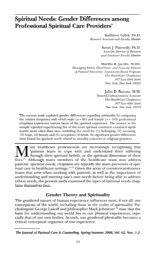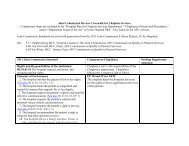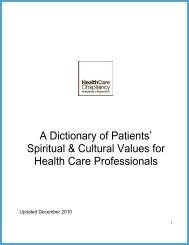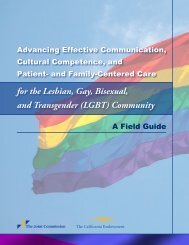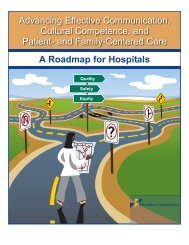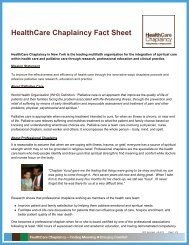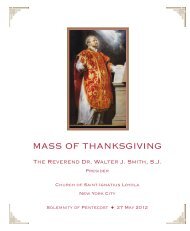Discerning Patient Needs - HealthCare Chaplaincy
Discerning Patient Needs - HealthCare Chaplaincy
Discerning Patient Needs - HealthCare Chaplaincy
Create successful ePaper yourself
Turn your PDF publications into a flip-book with our unique Google optimized e-Paper software.
Edition 4 of a Series<br />
<strong>Discerning</strong> <strong>Patient</strong> <strong>Needs</strong>: Spiritual Assessment<br />
Perspectives for Health Care Chaplains<br />
Series Editor: P Scott Richards<br />
Counseling Psychology and Special Education, Department of Education, Brigham Young<br />
University<br />
I. Rationale<br />
Despite growing professional awareness of the importance of religion and spirituality in health<br />
and human welfare, patients’ religious backgrounds and spirituality may be overlooked by<br />
physicians, nurses, psychologists, and other health care professionals. Chaplains can fulfill a<br />
crucial role in health care settings by making sure that patients’ spiritual beliefs and needs are<br />
carefully assessed and fully understood. This information may prove valuable for all members<br />
of the health care team. By understanding patients’ spiritual worldviews, health care<br />
professionals are better able to empathically understand them. Spiritual assessment can also<br />
help health care professionals determine if clients have unresolved spiritual concerns or needs.<br />
Physical healing and psychological coping may be complicated if patients are experiencing<br />
spiritual distress. Appropriately addressing patients’ spiritual concerns and needs can<br />
contribute to more rapid recovery and better prognosis. A spiritual assessment can also help<br />
health care professionals identify patients’ whose spiritual and psychological distress is<br />
sufficiently severe and persistent as to warrant referral for longer-term professional help after<br />
hospital discharge. A number of potentially useful religious-spiritual assessment strategies and<br />
methods have been described in the professional literature. This bibliographic series<br />
introduces chaplains to this literature. Ultimately, for health care professionals who believe<br />
that human beings may receive enlightenment and inspiration from the divine, a spiritual<br />
assessment may be more than just conceptualizing information that has been gathered in<br />
intake questionnaires, clinical interviews, and objective or projective assessment measures. A<br />
spiritual assessment may also include prayerful or meditative efforts to seek spiritual<br />
impressions and insights about patients and their problems and how to assist them.<br />
1
II. Three-Five of the Best Books or Articles The first entry summary and commentary on<br />
Fitchett and the second on Fitchett and Risk are reprints from Reverend George Handzo’s “By<br />
Its Fruits: The Science of Health Care <strong>Chaplaincy</strong>” in Practical Bearings: The Critical<br />
Bibliography for Health Care Chaplains, Vol. 1, No. 1, (February, 2009). The first three<br />
books/articles in this section were written by pastoral professionals for pastoral professionals<br />
and have direct relevance to the work of chaplains. The second two chapters/articles were<br />
written for primarily for physicians, but they are included because they provide much insight<br />
that is of importance to health care chaplains.<br />
Fitchett, G. (1993) Assessing Spiritual Need: A Guide for Caregivers. Minneapolis, Minnesota:<br />
Augsburg/Fortress Press.<br />
Summary<br />
George Fitchett presents a model for spiritual assessment that he and his colleagues<br />
developed, as illustrated with case studies. This “7X7” model has become a classic from which<br />
many other models are derived. He reviews three other models and provides a framework for<br />
evaluating them. The framework includes the model’s concept of spirituality, norms and<br />
authority, and assessment context and process. The models include Paul Pruyser’s The<br />
Minister as Diagnostician, Elizabeth McSherry’s work at the Veterans Administration, and the<br />
model of the North American Nursing Diagnostic Association. This book addresses many of the<br />
questions pastoral caregivers have raised about this timely and enduring topic and provides an<br />
informed and balanced approach for making decisions about spiritual assessment models and<br />
tools.<br />
Comment<br />
Good assessment needs to be the cornerstone on which all of pastoral care delivery is built. It<br />
drives the plan of care, interventions, and outcomes. It surfaces the facts that communicate to<br />
other disciplines what chaplaincy does. As a side note, it is important to distinguish spiritual<br />
screening, which any staff person can do, and spiritual assessment, which should be the<br />
prerogative of the professional chaplain. Many chaplains have avoided doing assessment<br />
because professional pastoral care does not have a standard method. All chaplains need to<br />
realize that what is most important is to have a system that becomes standard for them and for<br />
their colleagues in a given institution so that other disciplines come to understand what they<br />
are doing.<br />
2
Fitchett, G., & Risk, J. Screening for Spiritual Risk. Journal of Pastoral Care & Counseling. In<br />
Press.<br />
Summary<br />
For years George Fitchett has been the leading authority on spiritual assessment and<br />
screening. The article describes a brief screening protocol for use identifying patients who may<br />
be experiencing religious/spiritual struggle, as well as patients who would like a visit from a<br />
chaplain. They describe the results of a pilot study in which non-chaplain healthcare colleagues<br />
administered the screening protocol to patients on admission. The protocol identified 7% of<br />
the patients as possibly experiencing struggle. The protocol generated a very low rate of false<br />
positives and a somewhat higher rate of false negatives.<br />
Comment<br />
Increasingly, pastoral care in healthcare settings is focused on need for care rather than desire<br />
for care. For chaplains to demonstrate outcomes that contribute to healing, they have to<br />
demonstrate need. Until now, there has been no screening protocol for pastoral care. The<br />
screening protocol from Fitchett and colleagues provides an extremely simple, effective and<br />
easily taught method to identify patients with religious struggle. It can easily be inserted into<br />
any nursing or admitting assessment.<br />
Ledbetter, Timothy J. (2008). Screening for pastoral visitations using the Clinical + Coping<br />
Score. The Journal of Pastoral Care and Counseling, 62 (4), 367-373.<br />
Abstract<br />
Hospital chaplains struggle to know which patients most likely need pastoral care and why.<br />
The author presents a computerized model to screen and document indicated patients. A new<br />
screening tool is introduced, the Clinical + Coping Score, which can check with greater<br />
precision for patients who show evidence of insufficient coping. This screening model informs<br />
the subsequent assessment and intervention opportunities, though they are not discussed.<br />
The model’s format enables chaplains to efficiently and effectively document pastoral<br />
screening using the hospital’s electronic charting program. Two levels of visitation priority are<br />
suggested. In so doing, the chaplains are able to identify the indicators for pastoral care<br />
contacts and interventions, as well as the number of patients whose recognized needs have<br />
yet to be addressed (Ledbetter, 2008, p. 367).<br />
3
Comment<br />
This is a practical, applied article that describes a model for assisting hospital chaplains in<br />
deciding which patient are in greatest need of pastoral care. The model is simple, and yet<br />
practical, and provides a framework in which chaplains consider patients’ medical status<br />
(stable, serious, or critical) and coping resources (full, adequate, marginal, and deficient) as<br />
they screen patients for potential pastoral visits. Chaplains in training would benefit from<br />
reading and discussing this article before their first hospital placement.<br />
Kristeller, J. L., & Hummel, L. M. (2006). Spiritual engagement and<br />
transformation in cancer patients: The experience of the patient, the role of the physician. In<br />
Joan Koss-Chioino and Philip Hefner (eds.), Spiritual Transformation and Healing:<br />
Anthropological, Theological, Neuroscientific, and Clinical Perspectives, Lanham, MD:<br />
Rowan and Littlefield Press.<br />
Summary<br />
This chapter addresses the general question of the quality of the spiritual experience of the<br />
patient and the related question of how such issues might be appropriately explored within the<br />
medical setting by the physician. It also addresses the question of whether there is an<br />
appropriate and effective way for oncologists to explore the issue of spiritual or religious<br />
concerns with their patients, and it explores how patients may experience both that type of<br />
inquiry and their own experiences in drawing on spiritual or religious resources. The authors<br />
describe a brief, patient centered approach that oncologists can use in assessing and<br />
addressing patients’ spiritual concerns, which they call the OASIS inquiry (Oncologist Assisted<br />
Spirituality Intervention Study). The authors’ research suggests that not only does a brief,<br />
patient-centered inquiry, such as the OASIS approach, appear to be acceptable to most<br />
patients and relatively comfortable for physicians, but there is an increase in patients’<br />
satisfaction with care and at least preliminary evidence of improved quality of life for some<br />
patients. Whether it is appropriate for physicians to explore the spiritual or religious concerns<br />
of their patients remains a matter of legitimate debate and physician choice.<br />
Comment<br />
4
This book chapter explores many issues that are important for health care professionals,<br />
including chaplains who work in health care settings. It builds a strong rationale for why it is<br />
important for physicians to assess and address patients’ spiritual needs during medical<br />
treatment, particularly oncology patients. The authors respectfully acknowledge both<br />
philosophical and practical reasons why physicians might resist doing any sort of a spiritual<br />
assessment of their patients. However, they argue effectively that a brief, patient-centered<br />
assessment is both possible and desirable. One of the outstanding things about this chapter is<br />
that it reports the findings of two research studies which provide empirical support for the<br />
hypothesis that a brief, patient-centered spiritual assessment approach can be effectively used<br />
by physicians and benefits patients. Thus, this chapter not only provides a spiritual assessment<br />
approach for physicians, but it also models how health care professionals, including chaplains,<br />
can empirically evaluate spiritual assessment approaches for health care settings. The authors’<br />
OASIS spiritual assessment approach is one of the very few that has been empirically<br />
evaluated and supported. Hopefully, chaplains and other health care professionals will “go<br />
and do likewise” with spiritual assessment approaches they may develop. This chapter may<br />
also help chaplains more fully understand spiritual assessment from the perspective of<br />
physicians and increase their ability to collaborate effectively with physicians in patient care.<br />
Puchalski, C. (2006). Spiritual assessment in clinical practice. Psychiatric Annals, 36 (3), 150-<br />
155.<br />
Summary<br />
Spiritual needs are important to many patients. There is institutional support for the inclusion of<br />
spiritual care in the holistic care of patients. There is also data that patients want their spiritual<br />
beliefs integrated into the care of their patients and that spiritual beliefs may benefit patients in<br />
some healthcare outcomes, resiliency to stress and adverse situations, and coping with<br />
suffering. A spiritual history provides an opportunity in the clinical encounter for the patient to<br />
share spiritual beliefs if that is what he or she chooses to do. It also helps the clinician to<br />
identify spiritual distress, as well as spiritual resources of strength, and to provide the<br />
appropriate therapy and referrals needed to give the patient the best care from a bio-psychosocial-spiritual<br />
framework (Puchalski, 2006, pp. 154-155). The author describes her spiritual<br />
history “FICA” model as follows (Puchalski, 2006, p. 153):<br />
F — Faith and Belief<br />
5
“Do you consider yourself spiritual or religious?” or “Do you have spiritual beliefs that help you<br />
cope with stress?” If the patient responds “no,” the physician might ask, “What gives your life<br />
meaning?” Sometimes patients respond with answers such as family, career, or nature.<br />
I — Importance<br />
“What importance does your faith or belief have in our life? Have your beliefs influenced how<br />
you take care of yourself in this illness? What role do your beliefs play in regaining your<br />
health?”<br />
C — Community<br />
“Are you part of a spiritual or religious community? Is this of support to you and how? Is there<br />
a group of people you really love or who are important to you?” Communities such as<br />
churches, temples, and mosques, or a group of likeminded friends, can serve as strong<br />
support systems for some patients.<br />
A — Address in Care<br />
“How would you like me, your healthcare provider, to address these issues in your<br />
healthcare?” Often it is not necessary to ask this question but to think about what spiritual<br />
issues need to be addressed in the treatment plan. Examples include referral to chaplains,<br />
pastoral counselors, or spiritual directors, journaling, and music or art therapy. Sometimes the<br />
plan may be simply to listen and support the person in their journey.<br />
Comment<br />
This article provides a strong rationale for why it is important to assess spiritual issues in health<br />
care settings. It offers suggestions to help health care professionals recognize spiritual issues<br />
in the clinical setting. It provides concrete suggestions about how to take a spiritual history in<br />
medical settings. Although the article is directed primarily to physicians, chaplains may also<br />
find the rationale and spiritual history approach useful for their own practices. When chaplains<br />
are given opportunities to provide training about spirituality to physicians, nurses,<br />
psychologists, and social workers, this article may be useful for helping these members of the<br />
health care team more fully understand the importance of conducting spiritual assessments.<br />
II.<br />
Five to Ten other Books or Articles<br />
A number of the articles and book chapters in this section were written by<br />
psychologists or social workers for mental health professionals, but are included<br />
because they have considerable relevance to the work of health care chaplains.<br />
Several of the articles in this section were written by chaplains and provide valuable<br />
perspectives, but in my view did not fall into the category of the “five best” on the<br />
topic of spiritual assessment.<br />
6
Hodge, David R. (2006). A template for spiritual assessment: A review of the JCAHO<br />
requirements and guidelines for implementation. Social Work, 51(4), 317-326.<br />
Abstract<br />
Growing consensus exists regarding the importance of spiritual assessment. For instance, the<br />
largest health care accrediting body in the United States, the Joint Commission on<br />
Accreditation of Healthcare Organizations (JCAHO), now requires the administration of a<br />
spiritual assessment. Although most practitioners endorse the concept of spiritual assessment,<br />
studies suggest that social workers have received little training in spiritual assessment. To<br />
address this gap, the current article reviews the JCAHO requirements for conducting a spiritual<br />
assessment and provides practitioners with guidelines for its proper implementation. In<br />
addition to helping equip practitioners in JCAHO-accredited settings who may be required to<br />
perform such an assessment, the spiritual assessment template profiled in this article may also<br />
be of use to practitioners in other settings (Hodge, 2006, p. 317).<br />
Comment<br />
The target audience for this article is social workers and treatment facilities, but chaplains<br />
working in health care settings may find the discussion of JCAHO recommendations about<br />
spiritual assessment very relevant. The author offers his views about how the JCAHO<br />
recommendations can be effectively implemented in clinical practice. For example, he<br />
recommends fewer assessment questions, but questions that are more open-ended in nature.<br />
He also suggests that a brief spiritual assessment may reveal the need to transition into a<br />
deeper second level assessment. The author’s discussion of cautions and caveats about<br />
performing more in-depth spiritual assessments are valuable, but will hopefully not discourage<br />
social workers and other clinicians to perform more in-depth spiritual assessments when<br />
indicated.<br />
Hathaway, William L. (2003). Clinically significant religious impairment. Mental Health,<br />
Religion and Culture, 6 (2), 113- 129.<br />
Abstract<br />
Recent psychodiagnostic practice, as embodied in the DSM IV, requires that<br />
psychopathological features result in a ‘‘clinically significant impairment’’ to qualify as a<br />
‘‘mental disorder’’ in many cases. The impairment must be in social, occupational, or other<br />
7
important areas of functioning. The current proposal is that clinicians should consider the<br />
potential impairment in religious functioning arising from mental disorders in diagnostic<br />
process. It is suggested that psychopathology may result in a clinically significant religious<br />
impairment that is defined as a reduced ability to perform religious activities, achieve religious<br />
goals, or to experience religious states, due to a psychological disorder. Various existing<br />
approaches to studying the relationship between religious functioning and psychopathology<br />
are briefly reviewed and roughly categorized as either focused on ‘symptomatic religiosity’ or<br />
reflecting a ‘religiously sympathetic’ posture. Yet, in both of these approaches, religion has<br />
predominantly been construed as an exogenous variable contributing to mental health in some<br />
fashion (for good, for ill, or for both). The current proposal suggests that clinicians should also<br />
consider religion in endogenous perspective. So construed, religion is a significant domain of<br />
adaptive functioning, which may be adversely impacted by psychopathology. A discussion of<br />
various clinical, research and ethical issues involved in realizing the proposal is provided<br />
(Hathaway, 2003, p. 113).<br />
Comment<br />
This article explores the idea that mental disorders can cause impairment in religious<br />
functioning, or in other words, result in a reduced ability for patients to perform religious<br />
activities, achieve religious goals, and to experience religious states, due to a psychological<br />
disorder. Chaplains in medical settings may frequently observe situations where patients’<br />
physical disorders are causing impairment in their religious functioning. The author’s article<br />
provides a rationale for the importance of chaplaincy services in the sense that when religion<br />
and spirituality are viewed as adaptive areas of human functioning that can be impaired by<br />
psychological or physical disorders the need to intervene pastorally to help patients who are in<br />
spiritual distress may be more readily understood by all members of the health care team.<br />
Richards, P. Scott, & Bergin, A. E. (2005). Religious and spiritual assessment (pp. 219 – 247).<br />
In P. S. Richards & A. E. Bergin (Eds.), A spiritual strategy for counseling and psychotherapy<br />
(2 nd ed.). Washington, DC: American Psychological Association.<br />
Summary<br />
In this chapter, the authors’ discuss a number of reasons why it is important for counselors and<br />
psychotherapists to assess clients' religious and spiritual backgrounds and status along with<br />
the other aspects of their lives. They identify and describe dimensions of religiosity and<br />
spirituality that are clinically relevant from a psychological perspective. They then describe a<br />
multilevel, multi-systemic psychological assessment strategy and discuss how a religious-<br />
8
spiritual assessment fits into such a strategy. The authors also discuss how intake<br />
questionnaires, clinical interviews, and standardized tests can be used to facilitate a religiousspiritual<br />
assessment. They discuss meta-empathy, or the idea that psychotherapists may on<br />
occasion experience intuitive insights and inspiration that assist them in understanding their<br />
clients. They also discuss the importance of assessing the spiritual outcomes of treatment.<br />
Comment<br />
This book chapter was written by psychologists for psychologists and has received positive<br />
reviews within the mainstream psychology profession. Its primary value for chaplains may be<br />
in the psychological perspective it provides about religious and spiritual assessment and in the<br />
validation it gives concerning the importance of spirituality in a comprehensive treatment<br />
approach. Understanding why a religious and spiritual assessment is important from the<br />
perspective of psychologists and other mental health professionals may help chaplains more<br />
effectively interface with them on the health care team. This chapter may give chaplains some<br />
additional insight into dimensions of spirituality that may be important in clinical settings.<br />
Chaplains may also find that the authors’ brief discussion of meta-empathy affirming of the<br />
non-quantifiable aspect of their role as spiritual caregivers and of the importance of the<br />
spiritual presence in chaplaincy care.<br />
Gorsuch, Richard L., & Miller, William R. (1999). Assessing spirituality (pp. 47 – 64). In W. R.<br />
Miller (Ed.), Integrating spirituality into treatment: Resources for practitioners. Washington,<br />
DC: American Psychological Association.<br />
Summary<br />
This practically focused chapter begins with a brief consideration of why mental health<br />
professionals should assess clients’ spirituality. The main body of the chapter is devoted to<br />
recommendations on how to assess spirituality in ways that are relevant to treatment. The<br />
authors start with broader approaches and proceed to more specific measures organized<br />
around the three broad assessment domains—cognitive, behavioral, and experiential. Finally,<br />
they offer a few general cautionary notes about this area of assessment.<br />
Comment<br />
This book chapter provides some strong rationales for why it is important for psychologists and<br />
other mental health professionals to assess the religious and spiritual dimensions of their<br />
clients’ lives. It provides useful suggestions about assessing clients’ religious beliefs,<br />
9
ehaviors, and experiences. Its primary value for chaplains may lie in helping broaden their<br />
understanding of religious and spiritual assessment from a psychological perspective.<br />
Millspaugh, D. (2005). Assessment and response to spiritual pain: Part I. Journal of Palliative<br />
Medicine, 8(5), 919-923.<br />
Abstract<br />
Spiritual pain or suffering is common. Cicely Saunders described persons with “total pain”<br />
including the physical, psychological, social, and spiritual dimensions. Yet, a construct for<br />
what it is, and how to respond, is not so common. In this paper, I hypothesize that the<br />
components of spiritual pain can be summarized in the following manner.<br />
Spiritual pain or Suffering =<br />
(Awareness of death + Loss of Relationships + Loss of Self) (Loss of Purpose + Loss of<br />
Control)/Life affirming and transcending Purpose + Internal Sense of Control<br />
Thus, an assessment of spiritual pain or suffering should examine the degree to which the<br />
individual is experiencing each of these components and their relationship to each other.<br />
Further, each of these components is dynamic, always in process, both within and between the<br />
components. A second paper will examine the sufferer’s religious responses and suggested<br />
pastoral responses (Millspaugh, 2005, p. 919).<br />
Comment<br />
This article provides a useful exploration of some potential causes of spiritual pain and<br />
suffering (e.g., awareness of death, loss of relationships, etc.). The article seems to derive<br />
primarily from the author’s clinical experience as a chaplain and so it provides a valuable, but<br />
perhaps limited perspective in this regard. I did not find the author’s algebraic formula of<br />
spiritual suffering helpful in the sense that I think it oversimplifies something that is much more<br />
complex. Simplifying complex ideas can often be helpful, but in this case I think the<br />
mathematical formula so distorts the relationships between various life experiences and<br />
personal characteristics that can cause and ameliorate spiritual pain and suffering that it is not<br />
helpful. Nevertheless, despite its limitations, I think this article provides some useful food for<br />
thought about the types and causes of spiritual pain and suffering patients may be<br />
experiencing. I think it may be especially useful for those who are early in their training as<br />
chaplains.<br />
10
Millspaugh, D. (2005). Assessment and response to spiritual pain: Part II. Journal of<br />
Palliative Medicine, 8(6), 1110-1117.<br />
Abstract<br />
In Part I of this article, published in October 2005, I hypothesized that the components of<br />
spiritual pain can be summarized in the following manner.<br />
Spiritual pain or Suffering =<br />
(Awareness of death + Loss of Relationships + Loss of Self) (Loss of Purpose + Loss of<br />
Control)/Life affirming and transcending Purpose + Internal Sense of Control<br />
Thus, an assessment of spiritual pain or suffering should examine the degree to which the<br />
individual is experiencing each of these components and their relationship to each other. Now<br />
in Part II I examine the Christian sufferer’s religious responses and suggest pastoral<br />
interventions (Millspaugh, 2005, p. 1110).<br />
Comment<br />
Millspaugh details several general categories of patient responses to spiritual pain—eight, to<br />
be specific. He then presents a section on “pastoral response” which discusses a number of<br />
issues, including self-assessment, pastoral presence, pastoral assessment, and spiritual care<br />
planning. Each of these provides detailed questions that chaplains may want to consider<br />
concerning the person suffering spiritual pain. I thought that this article had many helpful<br />
insights; however, in the latter half of the article was unfocused and suffered from<br />
repetitiveness and a lack of clarity and organization. There were various lists and the<br />
numbering was not consistent. One numbered list had a numbered list within it that was also<br />
numbered with plain, ordinal Arabic numerals. Later a different numbering structure was used.<br />
I once had a clinical supervisor who was fond of saying that when it comes to clinical practice,<br />
“It is better to be simple-minded than muddle-headed.” I think this article may leave readers<br />
feeling muddle-headed because of its lack of clarity, conciseness, and organization.<br />
Nevertheless, I think this article has value if readers are willing to make the effort to sort<br />
through the muddle-headedness and find the gems of clinical insight offered within it.<br />
Austin, Larry J. (2006). Spiritual assessment: A Chaplain’s perspective. Explore, 2(6), 540-<br />
542.<br />
11
Summary<br />
Austin’s brief article identifies a lack of collaboration between healthcare professionals and a<br />
lack of understanding and specificity of professional functions and concepts. He provides a<br />
set of categories for spiritual assessment as a “starting place for dialogue and collaboration<br />
among disciplines; sense of the Holy, actions of the Holy, beliefs and practices, affective<br />
responses, personal responsibility, community, meaning, vocation, hope, grief, humor,<br />
forgiveness, courage, and virtue and beauty” (Austin, 2006, p. 540). He then briefly explains<br />
each category, implying that each of these categories may be important to assess with<br />
patients.<br />
Comment<br />
This is a brief and basic article and may be most useful to those early in their training as<br />
chaplains to stimulate their thinking about possible ways to think about patients’ spirituality.<br />
To someone not yet familiar with chaplaincy or basic pastoral care, it may offer some new and<br />
helpful information.<br />
Gordon, Tom, & Mitchell, David (2004). A competency model for the assessment and delivery<br />
of spiritual care. Palliative Medicine, 18, 646-651.<br />
Abstract<br />
The delivery of spiritual and religious care has received a high profile in national reports,<br />
guidelines and standards since the start of the millennium, yet there is, to date, no recognized<br />
definition of spirituality or spiritual care nor a validated assessment tool. This article suggests<br />
an alternative to the search for a definition and assessment tool, and seeks to set spiritual care<br />
in a practical context by offering a model for spiritual assessment and care based on the<br />
individual competence of all healthcare professionals to deliver spiritual and religious care.<br />
Through the evaluation of a pilot study to familiarize staff with the Spiritual and Religious Care<br />
Competencies for Specialist Palliative Care developed by Marie Curie Cancer Care, the authors<br />
conclude that competencies are a viable and crucial first step in ‘earthing’ spiritual care in<br />
practice, and evidencing this illusive area of care (Gordon & Mitchell, 2004, p. 646).<br />
Comment<br />
12
This article provides some valuable perspectives about the challenges of assessing patients’<br />
religious and spiritual beliefs and background in hospital settings. The four-level religious and<br />
spiritual competence model also provides a useful way to think about religious-spiritual<br />
competency expectations in health care settings. The authors’ description of the pilot study<br />
they did among staff members in the Marie Curie Hospices was useful in the sense that it<br />
provides some food for thought about how religious-spiritual competencies might be<br />
encouraged among health care staff—and about the role chaplains might take in promoting<br />
such competencies. The weakness of the article may be that the authors remained rather<br />
vague about what specific religious-spiritual competencies they regard as important.<br />
Scott, Stacey, Garver, Stacy, Richards, Julie, & Hathaway, William R. (2003). Religious issues<br />
in diagnosis: The V-Code and beyond. Mental Health, Religion and Culture, 6, 161-173.<br />
Abstract<br />
This paper addresses the issues around considering clients’ religious and spiritual functioning<br />
as a matter of client diversity. Such issues may be under appreciated by many clinicians. The<br />
introduction of a religious and spiritual problem V-Code (V62.89) into the DSM-IV provided a<br />
significant accommodation of client religious and spiritual functioning in contemporary<br />
psychodiagnostics. The V-Code allows for explicit identification of a nonpathological religious<br />
or spiritual focus in treatment. The nature of and history of the V-Code’s inclusion in DSM-IV is<br />
briefly reviewed. The strengths and limitations of the V-Code for raising clinician awareness of<br />
the religious and spiritual domain of client functioning is discussed and illustrated by a number<br />
of case examples. The V-Code approach is contrasted with Hathaway’s (2003) clinically<br />
significant religious impairment concept. Both are viewed as making complementary<br />
contributions to a religiously and spiritually sensitive clinical practice (Scott et al., 2003, p. 161).<br />
Comment<br />
Perhaps the primary value of this article for chaplains is that it may raise their awareness about<br />
the potential influence of the American Psychiatric Association’s Diagnostic and Statistical<br />
Manual’s (DSM) religious and spiritual problem V-Code on how psychiatrists and other mental<br />
health professionals think about religious and spiritual diagnosis and assessment. Overall, the<br />
authors express concerns that the DSM V-Code is a poor tool in the assessment of religious<br />
and spiritual issues and that it needs to be revised to be more helpful to clinicians.<br />
13
Gleason, John J. (1999). The four worlds of spiritual assessment and care. Journal of<br />
Religion and Health, 38(4), 305-317.<br />
Abstract<br />
From the dawn of human consciousness, religious and spiritual expressions have been<br />
inexorably intertwined with some degree of assessment toward more effective care—whether<br />
such care is offered by shaman, imam, rabbi, shirpa, prophet, priest, pastor, physician, nurse,<br />
or lay minister. Currently, two major forces have brought spiritual assessment and care into<br />
sharp focus regarding the delivery of health care in the U.S. The first is the advent of managed<br />
care. The shift in emphasis from sickness-based to wellness-based reimbursement, spurred by<br />
spiraling costs, has brought close scrutiny to provider effects on patient outcomes. The second<br />
major force, related to the first, has been increased attention to alternative medicine and to<br />
previously unacknowledged adjuncts to traditional health-care delivery, most often understood<br />
by the terms "holistic health" or "wellness." One of the sub-areas within holistic health is<br />
spiritual care. A measure of the increasing importance of spiritual care within the delivery of<br />
U.S. health care is the fact that the Joint Commission on Accreditation of Health Organizations<br />
(JCAHO) is gradually upgrading the place of chaplaincy services in the Standards. Thus, a<br />
clear, simple, user-friendly, inclusive, valid, reliable, useful diagnostic, care-anticipating, and<br />
outcomes-measurable spiritual-care model is becoming more a necessity in the increasingly<br />
demanding discipline of clinical chaplaincy (Gleason, 1999, p. 305).<br />
Comment<br />
This article describes a “four world” model for conceptualizing patients’ spiritual development<br />
along literal-mythical and open-closed dimensions. It also presents case examples of people in<br />
these “four worlds” with implications for chaplains. Findings from a study where the reliability<br />
and validity of an assessment approach based on the four-world model are also presented.<br />
Although the practical value of this spiritual assessment approach for chaplains in healthcare<br />
settings can be questioned, the article provides food for thought and debate as chaplains in<br />
training seek to clarify their own views about how they can most effectively conduct spiritual<br />
assessments with their patients.<br />
Flannelly, Kevin J., Galek, Kathleen, Tannenbaum, Helen P., Handzo, George F. (2007). A<br />
preliminary proposal for a scale to measure the effectiveness of pastoral care with family<br />
members of hospitalized patients. Journal of Pastoral Care and Counseling, 61, 19-29.<br />
Abstract<br />
14
The authors conducted an electronic search of the Medline database for articles measuring<br />
family satisfaction. Content analysis was then performed on the relevant studies to determine<br />
the types of themes included in scales measuring family satisfaction in healthcare settings. The<br />
authors used these themes to develop a scale for measuring the effectiveness of pastoral care<br />
with family members. A convenience sample of chaplains that was asked to judge the<br />
usefulness of each of the scale items, rated them all, on average, to be "somewhat useful" to<br />
"very useful" for evaluating chaplains' effectiveness. The value of the scale is discussed in<br />
terms of its being a more outcome-oriented measure of effectiveness compared to typical<br />
family satisfaction instruments (Flannelly et al, 2007, p. 19).<br />
Comment<br />
The focus of this article is not about assessing patients’ religious-spiritual issues, but on<br />
describing the development of a scale for assessing the outcomes of the pastoral services<br />
chaplains provide to the family members of hospitalized patients. This article may be valuable<br />
for chaplains who are concerned about assessing the outcomes of their pastoral care for a<br />
couple of reasons. First, the process of scale development it describes may assist chaplains<br />
who wish to develop their own outcome assessment measures. Second, the scale the authors<br />
developed for measuring the effectiveness of pastoral care with family members may prove<br />
useful for chaplains who wish to assess the effectiveness of this aspect of their work.<br />
Your feedback on Practical Bearings is important.<br />
Please click here and fill out the short evaluation form.<br />
15



